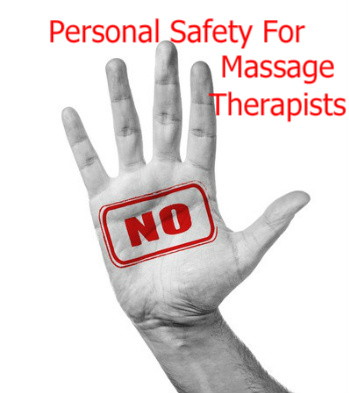- Home
- Massage Business
- Personal Safety
As an affiliate for Bookshop, Amazon, and other programs, I may earn a small commission for products purchased through links. This doesn't affect the price you pay. Privacy policy and disclosures.
Search this site:
Personal Safety for Massage Therapists: Tips to Stay Safe
While personal safety may not be something a massage therapist wants to think about, the old adage "an ounce of prevention is worth a pound of cure" is apt. Here's some advice from an ex-cop turned massage therapist.

by Lavon Watson
Your new client arrives at your office with his diagnosis in hand from a doctor you know and trust. The prescription for treatment clearly guides your work to focus on his idiopathic bilateral foot pain. Your intake process is not especially revealing, so you start your session with an eye towards first determining the best strategy for moving ahead.
As with many clients, this one inquires if you can provide a full-body massage, as that’s what he’s used to. You tell him that although you can work in ways that support the treatment plan, the focus of your time needs to be on relieving his foot pain since his insurance company is paying the bill.
All is well until about 40 minutes into your session, when your client mentions that he’s had his feet worked on at some local foot spas. Shortly after this revelation, your new client does the unthinkable and asks if you are open to providing him with what he refers to as a pleasurable finish to the session.
Suddenly you’ve gone from doing the clinical work that brought you into the massage profession to doing a type of threat assessment. In the back of your mind you’re wondering what you missed that would have tipped you off that your client might ask for something other than massage.
After you’ve set the new client straight on who you are and what you do and send him on his way, you reflect on what happened. You recall that he mentioned he wasn’t comfortable filling out your intake form. In this day and age, where stealing an identity is common, some clients can be a little more guarded about sharing their personal information, but in hindsight this situation seemed a little different.
However, what unnerves you the most is remembering that a local attorney was sentenced to 25 years in prison for sexually assaulting five women who were working as massage providers
Does this story sound unlikely? Maybe so, but a massage therapist gave me the basic details of this incident, and the sad reality is her experience is not an isolated incident.
Personal Safety for Massage Therapists
The good news is that personal safety isn’t difficult to practice, and you’re probably already doing a lot without even thinking about it. The following personal safety tips for massage therapists are no amazing revelation but can serve as a reminder of how to create a safe environment:
1. Screen calls from new clients carefully: Have a script written down or in your head and take your time when dealing with new clients, listening carefully for nuances related to their intentions and purpose. If you run a clinic where desk help does this function, make sure the appointment-setter is aware of this responsibility and trained to do it. You also should develop practices that support screening when you use online scheduling on your massage business website. I suggest no same-day appointments, a requirement for a phone number, and a prompt call to the number to make sure it’s valid.
2. Let new clients know you will call them back and then do: Getting a client’s phone number is common practice, but not every therapist calls the client back with an appointment reminder. This practice is just good business, but more importantly if a person doesn’t want to provide you with a call-back number, that’s a red flag you shouldn’t ignore.
3. Try and not work solo: Sometimes working alone is the nature of massage practice, especially with home-based practices. Just have someone who knows you’re with a client and be sure your client knows or believes you aren’t alone.
4. Avoid certain advertising venues: Look at the ads where you are thinking about advertising your practice. What do you see and who do you think may be seeking massage there? Unfortunately, some websites and print publications tend to represent massage as some sort of sexual experience, and regulatory agencies often pay far too little attention to this issue. You can choose to avoid the problems associated with those sites by not advertising on them.
5. Use an intake form: Yes, people can lie on these forms, but people with bad intentions hate these forms, and using one sends a strong message about your intentions.
6. Consider taking a personal safety or self defense class: These classes are widely available and can add to your safety toolbox both at work and elsewhere. I also recommend any of the available small 130-decibel personal alarms that you can buy for under $30.
7. Be careful about marketing yourself too quickly: You need to earn a living but don’t be too quick to introduce yourself to trouble. If someone you meet shows interest in your services, ask for a phone number and let the person know you will be in touch once you can look at your schedule. Simply put, slow things down to a pace that allows you to consider what’s really going on.
8. Don’t operate out of fear: I know, after all of the above, how can you not be a little fearful? However, confidence is palpable; people feel it through your hands when you work on them. It’s also something you can project verbally and through posture and other means. Predators prefer to target the weak and vulnerable, and though you can’t manage their perceptions, you can project strength and confidence. No matter where you are emotionally today, learn to turn on the switch of your confidence when dealing with potential clients. This skill set can serve you anywhere.
9. Have a plan: The best time to figure out what to do isn’t in the midst of a crisis. Think through some potential scenarios in advance or discuss potential situations with colleagues. No one understands what you deal with better than other massage therapists. The problem is that working as a massage therapist can be isolating and can leave you with a short list of ideas and options.
10. Don’t rely only on a weapon for protection: After the sexual assaults in the Seattle area, social media went crazy with therapists talking about arming themselves with weapons. There’s a lot to think about here, and be sure you think this idea through carefully. The massage environment is unique, and it’s important to keep that environment in mind when thinking about carrying a weapon. Police officers don’t take firearms into the booking area because the last thing they want is to wrestle over a firearm in a small space. Does that scenario sound familiar?
11. If something does go wrong, do not blame yourself: The reality is that everyone faces numerous decisions about their well-being every day. Discard the notion that someone trying to harm you is your fault. Self blame is purposeless and misdirected.
You can weave all these tips for personal safety for massage therapists into your practice seamlessly without making your clients feel like common criminals. You use good body mechanics when doing massage to save your body, and your client never knows it. Implementing personal safety tips can work in much in the same way, but it requires practice and commitment.
About the Author
Lavon “Butch” Watson is a retired police detective and a retired licensed massage therapist. In 2008 he began combining his diverse skills and became an acknowledged expert on the problems surrounding prostitution masquerading as massage and the men, who call themselves “hobbyists,” who attempt to solicit sexual acts from massage therapists. He taught ethics classes and personal safety for massage therapists until 2020.
Buy essential oils from Aromatics International (recommended).
Rocky Mountain Essential Oils.



